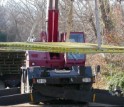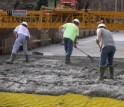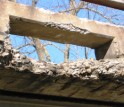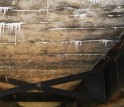News Release 06-040
Easy Up, Not-So-Easy Down
Builders replace bridge in only days using lightweight, corrosion-resistant composites
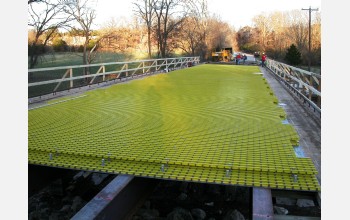
Fiberglass-polymer composites form the core of a renovated bridge deck in Springfield, Mo.
March 2, 2006
This material is available primarily for archival purposes. Telephone numbers or other contact information may be out of date; please see current contact information at media contacts.
Using new fiberglass-polymer materials, contractors in Springfield, Mo., have just subjected a decaying, 70-year-old bridge to a makeover that was as quick as it was dramatic.
Instead of snarling traffic for two to three weeks while they repaired the crumbling deck, girders and guardrails by conventional methods--laying plywood, tying steel rebar and pouring concrete--the workers used pre-fabricated plates and cages developed by a National Science Foundation (NSF)-supported university-industry partnership to finish the job in a mere five days.
The NSF's Repair of Buildings and Bridges with Composites Industry-University Cooperative Research Center is based at the University of Missouri at Rolla and North Carolina State University. The Missouri researchers joined with their industry partners and colleagues at the University of Wisconsin at Madison to develop the new construction solution.
The target of the makeover, an old bridge on Farm Road 148 near Springfield, was one of as many as 156,000 U.S. bridges in need of repair. In fact, it was posted, meaning that local officials had imposed a vehicle weight limit due to the dangerous bridge conditions. Now, however, a fresh layer of concrete conceals the technology responsible for the rapid replacement of the bridge’s crumbling deck and guardrails.
"A key to tackling the challenge of making thousands of deficient bridges in the nation fully operational and safe again is the development of convenient solutions for the rapid construction of long-lasting bridges," says Fabio Matta, a Ph.D. candidate in structural engineering who helped develop the new construction system. "Advanced composites make the margin for improvements exceptional," he added.
The fiberglass-polymer composites are strong enough to endure several decades of traffic--and unlike steel, will resist the ravages of salt and other corrosive de-icers for just as long. Due to the lightweight and prefabricated nature of the materials, moreover, workers can put the structures in place quickly, saving both time and commuter headaches.
"Since its inception in 1998, we have worked with our NSF I/UCRC partners to provide solutions for our ageing infrastructure," says Antonio Nanni, director of the Missouri center.
"We have demonstrated the economical and technical feasibility of several very attractive technologies," Nanni added. "Their full deployment will become possible only with the modification of existing codes and standards. It is a long process, but we are seeing light at the end of the tunnel."
The bridge, renovated with a grant from the U.S. Department of Transportation, was rededicated on Feb. 22, 2006.-NSF-
-
A small crane can lift and position the enormous fiberglass-polymer composite plates.
Credit and Larger Version -
The new composites were critical for both the bridge deck renovation and the guardrail replacement.
Credit and Larger Version -
Workers covered the composites with concrete in the final steps of the bridge renovation
Credit and Larger Version -
Before renovation, the guardrails on this Springfield, Mo., bridge were in dire need of repair.
Credit and Larger Version -
Before renovation, the underside of this Springfield, Mo., bridge deck was cracked and decaying.
Credit and Larger Version
Media Contacts
Joshua A. Chamot, NSF, (703) 292-7730, email: jchamot@nsf.gov
Mindy Limback, University of Missouri at Rolla, (573) 341-4268, email: limbackm@umr.edu
Program Contacts
Alex Schwarzkopf, NSF, (703) 292-5359, email: aschwarz@nsf.gov
Principal Investigators
Antonio Nanni, University of Missouri at Rolla, (573) 341-4497, email: nanni@umr.edu
Co-Investigators
Fabio Matta, University of Missouri at Rolla, (573) 341-6661, email: mattaf@umr.edu
Related Websites
University of Missouri at Rolla I/UCRC homepage: http://campus.umr.edu/rb2c/
Federal Highway Administration bridge safety statistics: http://www.fhwa.dot.gov/bridge/nbi.htm
Information on the NSF I/UCRC program: http://www.nsf.gov/funding/pgm_summ.jsp?pims_id=5501&from=fund
The University of Missouri at Rolla press release provides additional details.: http://news.umr.edu/news/2006/GreeneCoBridge.html
The U.S. National Science Foundation propels the nation forward by advancing fundamental research in all fields of science and engineering. NSF supports research and people by providing facilities, instruments and funding to support their ingenuity and sustain the U.S. as a global leader in research and innovation. With a fiscal year 2023 budget of $9.5 billion, NSF funds reach all 50 states through grants to nearly 2,000 colleges, universities and institutions. Each year, NSF receives more than 40,000 competitive proposals and makes about 11,000 new awards. Those awards include support for cooperative research with industry, Arctic and Antarctic research and operations, and U.S. participation in international scientific efforts.
Connect with us online
NSF website: nsf.gov
NSF News: nsf.gov/news
For News Media: nsf.gov/news/newsroom
Statistics: nsf.gov/statistics/
Awards database: nsf.gov/awardsearch/
Follow us on social
Twitter: twitter.com/NSF
Facebook: facebook.com/US.NSF
Instagram: instagram.com/nsfgov



